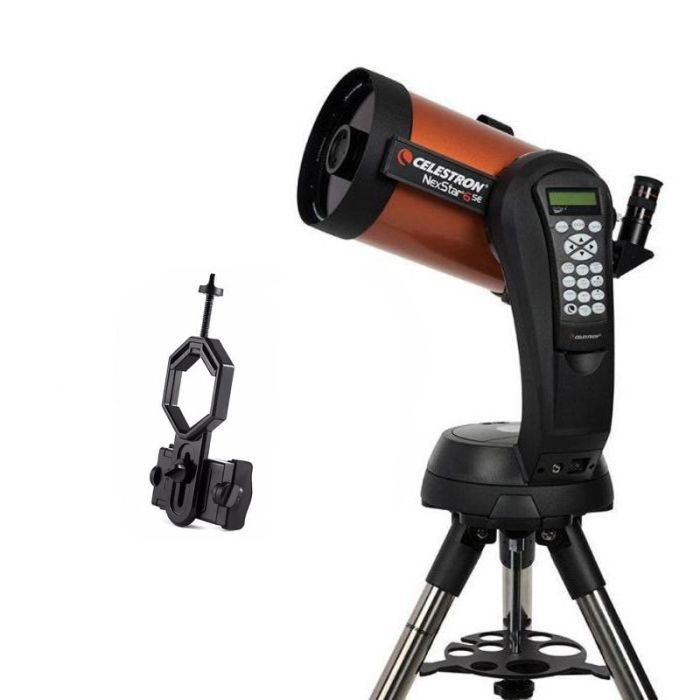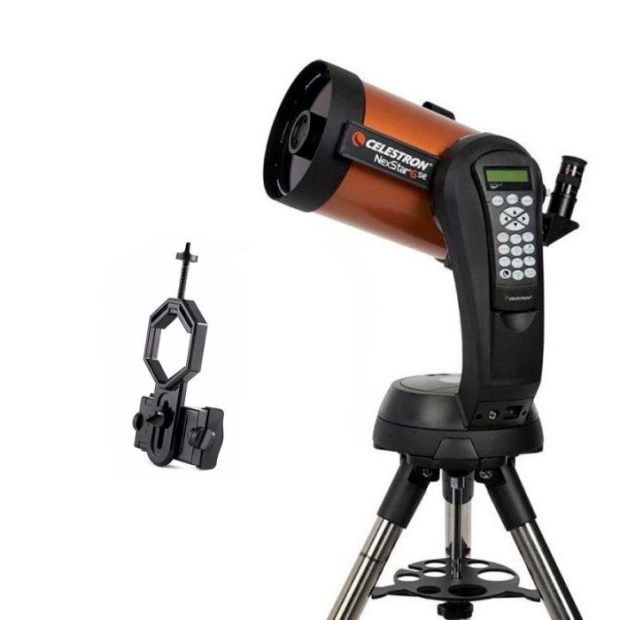
The Celestron NexStar 6SE is one of our best telescopes for under $1000.
Note: This post contains affiliate links. When you buy a product through the links in this article, we may earn a commission.
In this guide, we explore whether it’s possible to have a remarkable stargazing experience for under $1,000. (Short answer: Absolutely!) We’ve scoured the market and evaluated numerous models to bring you this list of best telescopes under $1,000, all to help ensure you don’t have to compromise on your observing experience.
When shopping for a telescope, consider the type of telescope, aperture size, the mount type, and several other features all significantly impact your stargazing experience.
A solid budget telescope should balance cost with functionality, offering clarity and ease of use without a hefty investment. Below are some of the most important factors to consider when purchasing a new telescope.
Aperture Size: The lens or mirror’s diameter in a telescope, known as the aperture, is a critical factor. A larger aperture allows more light to enter, producing brighter and clearer images. This is especially important for observing deep-sky objects like galaxies and nebulae. The aperture size not only affects the telescope’s light-gathering ability but also it resolving power, enabling you to see finer details.
Telescope Type: There are three main types of telescopes – refractors, reflectors, and compound (catadioptric) models. Refractors use lenses and are known for their sharp images and low maintenance, but they can be more expensive per inch of aperture. Reflectors use mirrors and offer larger apertures at lower costs, but they tend to require more maintenance. Compound telescopes combine features of both and are versatile, but they can be pricey.
Mount Type: The mount is the backbone of a telescope, providing stability and tracking capabilities. Altazimuth mounts are simple and intuitive, perfect for beginners and casual viewing. Equatorial mounts, however, are designed for more advanced tracking of celestial objects, which is essential for long-exposure astrophotography and detailed observations.
Optical Quality: Beyond aperture, the quality of the telescope’s optics is paramount. High-quality lenses and mirrors with proper coatings can significantly enhance your observing experience, delivering sharp, contrast-rich images. Poor optics can lead to aberrations and distorted images, diminishing the overall experience.
Ease of Use and Portability: Consider how user-friendly and portable the telescope is. Telescopes that are cumbersome to set up or difficult to operate can detract from your stargazing experience. A portable telescope is advantageous if you plan to observe from different locations or have limited storage space.
Additional Accessories: Included accessories such as eyepieces, a finder scope, or a tripod can add significant value to your telescope. These accessories can boost your viewing experience right out of the box, providing you with more versatility in what you can observe.
Finding the right telescope involves balancing all of the above factors to suit your individual needs and interests. Remember, the best telescope is the one you are going to use.
Related: The best telescopes for $500 or less | The best telescopes for kids
How do I choose between a refractor, reflector, or compound telescope?
Choosing the right type of telescope can be a pivotal decision in your astronomical journey. Each type – refractor, reflector, and compound – has its own unique characteristics, benefits, and drawbacks. Here’s a more detailed look at each type of telescope to help you decide which might be the best fit for your needs.
Refractor Telescopes
- Benefits: Refractors are known for their sharp, high-contrast images and are typically very durable and require little maintenance. They’re excellent for observing finer details on the Moon, planets, and binary stars. The closed tube design also means less cleaning and protection from air-borne particles.
- Drawbacks: Refractor telescopes can suffer from chromatic aberration (where different wavelengths of light come to focus at different distances), especially in simpler designs or larger apertures. Refractors also tend to be more expensive per inch of aperture compared to reflectors.
Reflector Telescopes
- Benefits: Reflectors typically provide larger apertures at a lower cost, making them ideal for deep-sky observing, where capturing more light is crucial for viewing galaxies, nebulae, and star clusters. Reflectors are often more compact and portable than refractors of the same aperture.
- Drawbacks: Reflectors tend to require more maintenance, such as regular collimation (alignment of mirrors). Plus, reflectors’ open-tube design means more exposure to dust and other elements.
Compound (Catadioptric) Telescopes
- Benefits: Compound, or Catadioptric, telescopes are hybrids, featuring both lenses and mirrors. They offer versatility and are more compact and lightweight than similarly sized reflectors and refractors, making them easier to transport. Compound telescopes are suitable for a wide range of astronomical observations.
- Drawbacks: These telescopes can be more expensive and may have a narrower field of view compared to other types. They also require some maintenance, though usually less than reflectors.
After understanding the different types of telescope, your choice will most likely depend on what you value most in your stargazing experience — whether it’s image quality, ease of maintenance, portability, or cost-effectiveness.
Here is our curated selection of the best telescopes under $1,000, which were chosen based on performance, user experience, and overall value.
- Features and Benefits: Equipped with a 6-inch aperture and a computerized GoTo mount, the NexStar 6SE is versatile for beginners and experienced astronomers alike. It offers bright, detailed views of both deep-sky and solar system targets, with a database of more than 40,000 celestial objects.
- What to Keep in Mind: This model is on the higher end of the budget.
- Why We Recommend It: The NexStar 6SE strikes a balance between portability and power, featuring a compact design and an easy setup process.
- Product Details:
- Type: Schmidt-Cassegrain
- Mount: Computerized Altazimuth
- Aperture: 6 inches (150mm)
- Focal Length: 1500mm
- Price: $875
Sky-Watcher EvoStar 80 APO Doublet Refractor
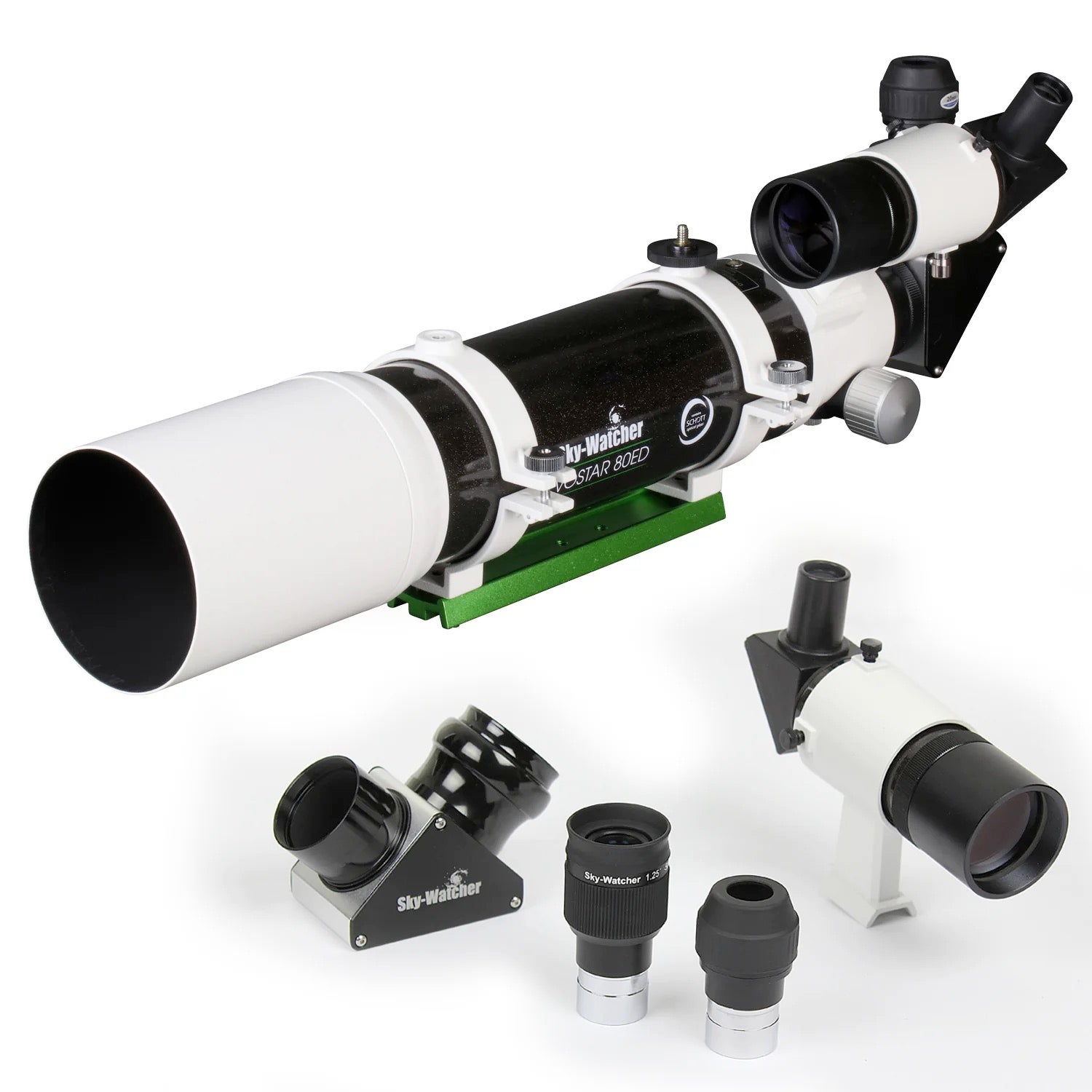
- Features and Benefits: Excellent for astrophotography, the EvoStar 80 APO boasts high-quality glass and coatings that produce sharp, color-accurate images.
- What to Keep in Mind: The smaller aperture may restrict some types of observations, particularly deep-sky viewing.
- Why We Recommend It: This refractor excels in astrophotography and sharp imaging, making it perfect for enthusiasts who want to photograph the cosmos.
- Product Details:
- Type: Refractor
- Mount: Mounting accessories included
- Aperture: 3.15 inches (80mm)
- Focal Length: 600mm
- Price: $950
- Features and Benefits: The XT8 offers excellent optical performance with its large 8-inch aperture and 1200mm focal length, making it ideal for detailed deep-sky viewing.
- What to Keep in Mind: Its larger size and weight may make it more challenging to transport and store. Additional accessories also may be required for advanced use.
- Why We Recommend It: Known for its superb visual clarity and ease of use, the Orion XT8 offers great value for both beginners and experienced astronomers.
- Product Details:
- Type: Dobsonian reflector
- Mount: Altazimuth
- Aperture: 8 inches (203mm)
- Focal Length: 1200mm
- Price: $649.99
Celestron Astro Fi 130 Wireless Newtonian Telescope
- Features and Benefits: This capable reflecting telescope features wireless operation with a smartphone app for easy targeting and tracking.
- What to Keep in Mind: The alignment process might be a bit challenging at first, especially for beginners.
- Why We Recommend It: Combining traditional reflecting optics with modern wireless controls offers a quick and easy way to hop between numerous cosmic targets.
- Product Details:
- Type: Reflector
- Mount: Altazimuth
- Aperture: 5.1 inches (130mm)
- Focal Length: 650mm
- Price: $559.95
Zhumell Z130 Portable Newtonian Reflector Telescope
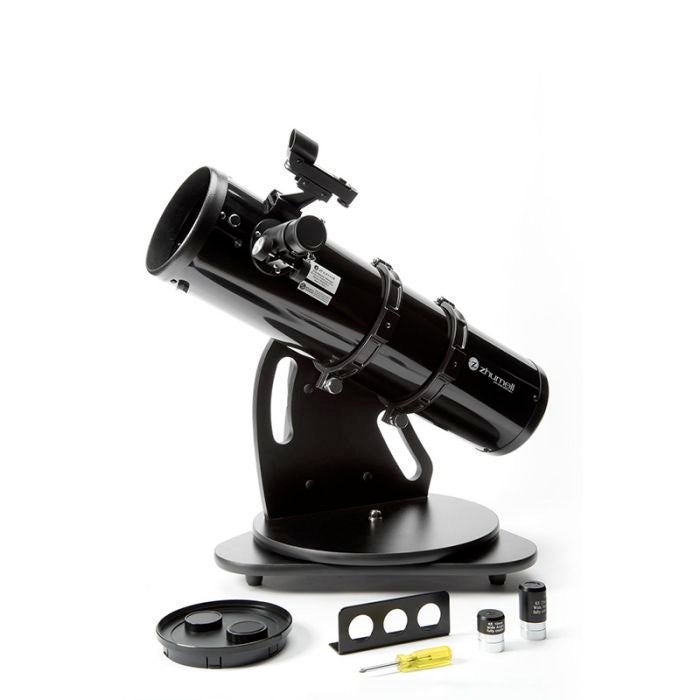
- Features and Benefits: Compact and user-friendly, the Zhumell Z130 is excellent for beginners. Its sizeable 5.1-inch aperture provides sharp images and is easy to set up on a sturdy surface.
- What to Keep in Mind: Requires a robust table or surface for stable use.
- Why We Recommend It: The Z130 is an affordable option that doesn’t compromise on image quality.
- Details:
- Type: Reflector
- Mount: Altazimuth
- Aperture: 5.1 inches (130mm)
- Focal Length: 650mm
- Price: $399.95
Celestron Omni XLT 120 Refractor
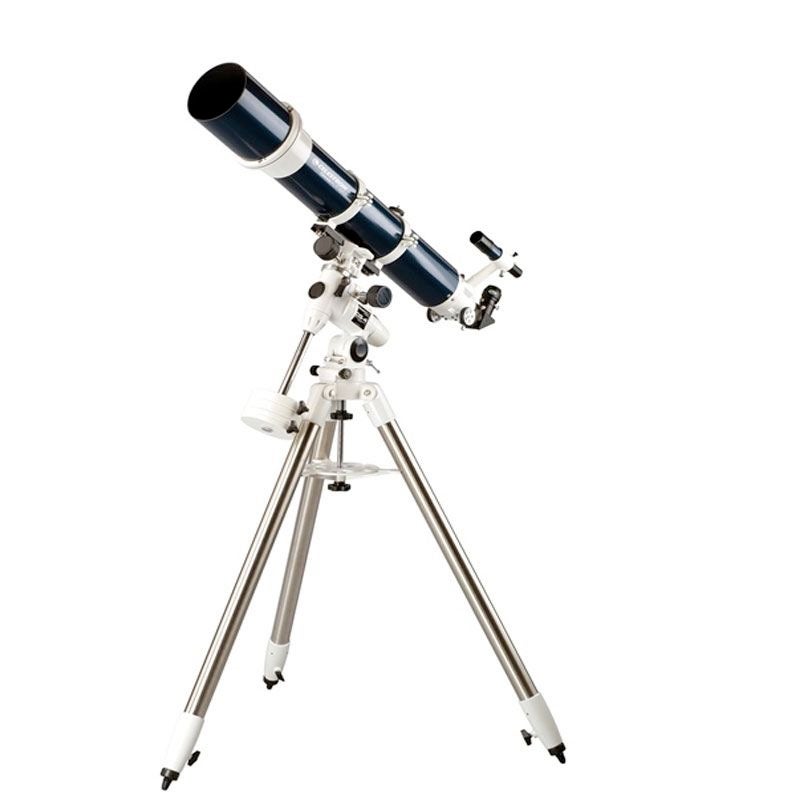
- Features and Benefits: A quality refractor telescope on a German Equatorial mount with setting circles and slow motion controls , suitable for both deep-sky and planetary viewing.
- What to Keep in Mind: May exhibit some chromatic aberration.
- Why We Recommend It: Good for beginners and intermediates due to its versatility and general-purpose capabilities.
- Product Details:
- Aperture: 4.7 inches (120mm)
- Price: $799.95
- Features and Benefits: A Newtonian telescope featuring an 8-inch mirror and a long focal length, the Apertura AD8 Dobsonian is great for observing planets and deep-sky objects.
- What to Keep in Mind: It’s a larger and heavier model, which may affect portability.
- Why We Recommend It: This model is known for providing excellent value as a visual telescope.
- Details:
- Type: Reflector
- Mount: Altazimuth
- Aperture: 8 inches (203mm)
- Focal length: 1200mm
- Price: $649.95
Care and maintenance of your telescope
Proper care and maintenance of your telescope play a vital role in ensuring its longevity and optimal performance. Below are just a few of the easiest and most effective ways to keep your telescope in tip-top shape:
Clean lenses and mirrors
- Frequency: Clean only when necessary to avoid unnecessary wear.
- Technique: Use a lens brush or air blower to remove dust. For smudges, apply a small amount of lens cleaning solution to a lens tissue or microfiber cloth, then gently wipe the lens or mirror.
- Avoid touching: Minimize direct contact with optical surfaces.
Store properly
- Environment: Keep your telescope in a cool, dry, and dust-free environment.
- Covers: Use protective covers or caps for the telescope and its accessories.
- Avoid sunlight: Store away from direct sunlight to prevent damage to the optics.
Perform regular maintenance checks
- Collimation: Especially for reflector telescopes, regular collimation (alignment of optics) is crucial for optimal performance.
- Check for wear: Periodically inspect all moving parts and optical surfaces for signs of wear or damage.
Avoid condensation
- Acclimatization: Allow your telescope time to adjust to outdoor temperatures before use to prevent condensation on lenses and mirrors.
- Avoid rapid temperature changes: Moving between extreme temperatures can cause condensation.
Handle and transport with care
- Carry Carefully: Always hold the telescope by its main body, not by its mount or optical tubes.
- Transportation: Use padded cases for transport, and ensure the telescope is secure and doesn’t move around in the vehicle.
General Upkeep
- Tighten Loose Parts: Periodically check and tighten any loose screws or components.
- Battery Care: For computerized telescopes, regularly check and replace batteries to avoid leakage and damage.
- Software Updates: Keep any software associated with your telescope up-to-date.
Consult the Manual: Always refer to your telescope’s manual for specific maintenance recommendations.
Frequently Asked Questions (FAQs)
How did we pick these telescopes?
To make our selections, we took into account a variety of factors, including user reviews and expert opinions from the Astronomy staff, with an emphasis on value for money. We also prioritized ease of use, making sure that even beginners could comfortably navigate their way around the skies. Additionally, we looked for versatility in each model, ensuring they could cater to a variety of astronomical interests and skill levels.
What is the best budget telescope for beginners? The Celestron NexStar 6SE stands out as the top choice for beginners due to its intuitive computerized GoTo mount and user-friendly interface. This telescope simplifies the process of locating celestial objects, making the initial foray into astronomy less daunting for novices. Its compact and portable design also means it’s easy to set up and use, a critical factor for those new to the hobby.
What is the best budget telescope for viewing planets? For planetary viewing, the Apertura AD8 Dobsonian stands out as an exceptional choice. The telescope’s substantial 8-inch aperture allows for excellent light gathering, which is crucial for revealing fine details on planetary surfaces. Additionally, the AD8’s longer focal length provides higher magnification potential, allowing for more detailed views of planetary details like the rings of Saturn, the clouds of Jupiter, and the surface features of Mars. Coupled with its stable Dobsonian mount, the AD8 offers both clarity and ease of tracking, making it an excellent choice for those keen on observing planets.
What is the best budget telescope for deep-space observations? The Orion SkyQuest XT8 is highly recommended for deep-space observation within a budget. This telescope’s large 8-inch aperture gathers ample light, necessary for viewing distant galaxies, nebulae, and star clusters in stunning detail. Its Dobsonian mount provides a stable base for long viewing sessions, and its simplicity makes it a great choice for both beginners and experienced astronomers interested in deep-space observing. Choosing the right telescope under $1000 is a worthwhile journey that will help you unlock the wonders of the night sky. And hopefully, this guide has helped steer you toward a telescope that not only fits your budget but also ignites your passion for astronomy. Happy stargazing!

